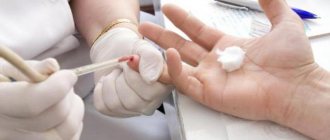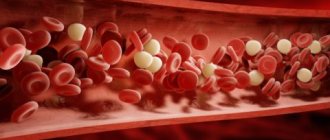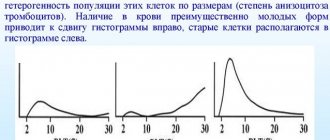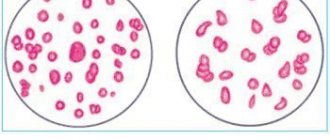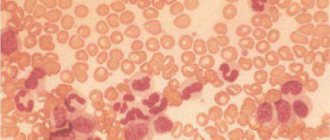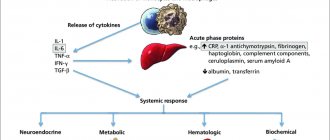Platelets are increased - the main symptoms are: Fatigue Itchy skin Bleeding gums Poor circulation Nosebleeds Numbness of fingers Increased fatigue Redness of the skin Bruises Deterioration of vision
An increase in the average platelet volume is not noticeable at the initial stage; it can only be detected using a blood test, in the morning, on an empty stomach. But if the average platelet volume is increased, it means that there are pathologies in the body that need to be eliminated. What does it mean if the average platelet volume is elevated? The causes and symptoms of this condition will be described below. There is also a good video selection about platelets and their research throughout the article and at the end of the article.
You can find out about an increase in the level of platelets in the blood only by taking a blood test
Platelet cells and their number
Returning to this topic, it is enough to remember that platelets are responsible for the function of the human circulatory system.
In particular, the viscosity (fluidity) of blood plasma and its natural ability to regenerate by forming clots of varying densities at sites of vascular damage depend on them.
Platelets live no more than 8-12 days. The average size of cells indicates their maturity (immature young ones are characterized by increased volume, “old” ones are noticeably reduced).
The most informative and quite accessible method for calculating the average platelet volume is from a blood smear taken from a finger.
This type of diagnosis allows you to determine the exact composition of components in the blood, which, in turn, indicates any changes in the body.
If previous results are confirmed/refuted, it is necessary to conduct a repeat (control) analysis under the same conditions.
Often, the platelet volume is normal, but the occurrence of hematomas on the body may indicate hidden problems.
How is the blood collection procedure performed?
The average platelet volume is increased, what does this mean?
Taking a blood test does not require any special preparation. As a rule, to carry out the blood sampling procedure, blood is taken from the capillaries of the fingers (usually the ring finger), less often - 5 ml from a vein (in children - up to 2 ml of blood). Before inserting the needle, the skin is treated with an antiseptic.
It is recommended to take a blood test in the morning, on an empty stomach. On the eve of the test, it is not recommended to eat spicy, fried, smoked foods, as well as pickles and alcoholic beverages.
Drinking water is allowed as usual. If possible, you will have to postpone taking medications or coordinate this issue with your doctor in advance.
Taking venous blood makes it possible to decipher information about the patient’s condition as accurately as possible, however, for primary diagnosis, a general blood test is sufficient.
The material taken for platelet testing is processed almost immediately, so automatic analyzers produce the finished result within 1-2 days.
Average volume and elevated platelet level
Abnormal changes in the blood, in which the average platelet volume is increased, and simply an increased platelet level are not the same thing.
The usefulness of the platelet population is indicated if the average volume of each platelet is analyzed individually. An increase in the number of platelet cells in 1 liter of blood without deciphering their qualitative characteristics indicates the development of thrombocytosis.
As a rule, the average platelet volume is increased if there are more immature forms of cells in the blood.
The fact is that mature cells occupy a much smaller volume in a limited blood volume than immature cells. The higher the deviation from the norm, the more defective the platelet cells are considered. This result is determined by performing an MPV analysis.
Symptoms
The average platelet volume, or more precisely, the deviation from normal parameters, has its own clinical manifestations. However, the problem is that any disorder can be completely asymptomatic, or the clinical manifestations are so mild that they go unnoticed.
If the average platelet volume is elevated, the following symptoms may occur:
- bleeding gums;
- easy formation of bruises that do not go away for a long time;
- nasal hemorrhages;
- excessively heavy periods in females;
- skin itching;
- weakness and fatigue;
- constant drowsiness;
- vision problems.
When platelet counts are below normal, symptoms will include:
- hemorrhages in the retina of the eye;
- formation of hematomas;
- frequent nosebleeds;
- the appearance of subcutaneous hemorrhages.
Retinal hemorrhage
In addition to the above symptoms, it is necessary to seek medical help as soon as possible in the following situations:
- a sharp decrease in body weight;
- extreme fatigue (to such an extent that a person cannot get out of bed);
- constant nosebleeds;
- hypertension;
- increased heart rate;
- cyanosis of the skin and excessive pallor of the mucous membranes.
Such symptoms are common for adults and children.
Normal index values
[ads-pc-2]
- The average normal platelet volume in a child under 1 month is 100 -400x109/l
- The average normal platelet volume in children under 1 year of age is 150–350x109/l.
- The average normal platelet volume in women during pregnancy is 150-380x109/l. It is no less dangerous when the average platelet volume is below normal and equal to 140x109/l. This is fraught with bleeding and fetal loss.
- The norm of platelets for men and women of any age is 150-400x109/l.
Indicators vary depending on the level of laboratory equipment and the quality of the research performed. For a detailed interpretation of the results, it is best to consult a general practitioner.
MPV performance standards
MPV is measured in µm3 or fl (femtoliters). This figure increases with age. A high MPV value indicates that a person's blood has more large platelets and is producing too many of them.
Large cells are young, meaning they have recently been released into the bloodstream from the bone marrow. Small ones have been circulating in the bloodstream for several days.
The MPV indicator itself cannot serve as the sole criterion for diagnosis. For example, an overall low platelet count and high MPV may be due to the fact that “old” platelets are being destroyed too quickly, and the bone marrow is trying to make up for their deficiency with new, larger cells.
In adults
The normal average values of this indicator for adults are shown in the table:
| Patient group | MPV, fl |
| Women | 7-11 |
| Men | 10-11 |
| People over 70 years old | 9,5-10,6 |
As can be seen from the above data, MPV in women varies within wider limits than in men. This is due to the fact that during menstrual bleeding, a change in platelet concentration occurs to facilitate endometrial shedding.
In children
In healthy newborns, the average normal MPV level is lower – 5.7±1.2 fl. The overall distribution of platelets by volume should be about 19%, and the platelet level should be 285±63 thousand in 1 μl. This value is associated with the immaturity of the hematopoietic system. It gradually increases with age.
During pregnancy
The MPV level increases during pregnancy, which is due to the body's natural defense against possible bleeding and fetal rejection.
Mean platelet volume (MPV) during pregnancy
Platelet indices also vary depending on the week of pregnancy. The normal value during this period may differ from the above by 10-20%.
Pathological changes in indices and what affects them?
The average platelet volume is increased
During the examination of blood samples, hematological analyzers produce results in the form of histograms, where data on the distribution of platelets by volume are represented by thrombocytometric curves.
Thus, the predominant presence of young platelet populations in the blood shifts the histogram to the right, and immature and “old” cells shift to the left in the figure.
If the average platelet volume is decreased or increased, this is a sure symptom of hidden diseases of the circulatory system. Identifying pathological conditions can be the first step towards timely diagnosis and speedy recovery.
The degree of decrease/increase in this indicator can be regarded as one of the criteria for analyzing the dynamics of the development of the pathological process and, accordingly, the effectiveness of treatment measures in the future.
Source: loveset.ru
Possible complications
The average platelet volume is increased in an adult in the presence of disturbances in the hemostatic system. The most serious complications are bleeding and deep vein thrombosis (including the pulmonary artery).
Impaired blood clotting, for which platelets are mainly responsible, leads to the development of hemorrhagic syndrome. It can manifest itself both in a mild form, in the form of petechiae (small subcutaneous hemorrhages), and in a severe form - hemorrhages in the brain, ending in death.
Deep vein thromboembolism is also associated with high mortality. Blockage by blood clots can occur in various areas - in the veins of the lower extremities, lungs, pelvic organs (damage to the kidneys, liver) and heart. In this case, tissue infarction occurs. The risk of this complication is especially high in severe injuries, burns and in the postoperative period.
Norms and interpretation of results
The average platelet volume is an indicator that is calculated during a complete blood test. It is designated MPV. This indicator gives an idea of the qualitative characteristics of platelets: it allows you to determine the number of blood cells produced and their usefulness (mature or immature cells), which part of them is susceptible to adhesion.
Note! The analysis is carried out in the morning on an empty stomach; in the evening it is undesirable to consume fatty foods and alcohol. The study is carried out no later than two hours after blood sampling - otherwise the result will be unreliable.
Explanation of MPV indicator:
- Shift of the graph to the left - old platelets predominate in the blood;
- To the right are the young people.
Young blood cells are larger, so if there are more of them in the blood, the average volume will be increased. If old cells that are smaller in size predominate, then the average platelet volume will be reduced. The average platelet volume in the blood ranges from 7 to 11 femtoliters.
Important! An increase in platelet volume indicates an increased production of blood cells by the bone marrow, which do not have time to be eliminated from the body. As a result, the viscosity and thickness of the blood increases. This condition may be a variant of the norm (if the volume is slightly increased or is at the upper limit of normal), or indicate the presence of diseases. To clarify the diagnosis, you need to consult a doctor.
Why is the child higher than normal?
In some cases, the number of platelets in a child's blood may be elevated. High platelet levels in children can occur:
- due to congenital pathologies of the spleen and red bone marrow;
- due to inflammatory processes;
- parasite infestation;
- infections (toxoplasmosis, meningitis, hepatitis);
- viruses;
- iron deficiency;
- stress and anxiety;
- overwork;
- during the period of hormonal maturation;
- due to intensive growth;
- poor nutrition, dehydration.
Elevated platelets in a child’s blood are not a reason to panic. It is necessary to consult a doctor in time, diagnose the problem and begin treatment as quickly as possible.
Causes
The mean platelet volume in the blood can be elevated for physiological and pathological reasons. In the second case, this condition requires treatment. In the initial stages, it is often enough to change habits and lifestyle, to maintain health using traditional medicine. And as the disease progresses, drug therapy will be needed.
Platelets promote blood clotting
When is an increase in mean platelet volume normal?
Platelets play an important role: they promote blood clotting, prevent significant blood loss, and thanks to them, tissue healing occurs faster. Therefore, in some cases, an increase in the average volume is justified and is positive, indicating the proper functioning of the hematopoietic organs.
In what cases is an increase normal?
- In newborns due to the immaturity of the hematopoietic organs.
- After injuries or surgical interventions accompanied by large loss of blood.
- During menstruation in women, especially with heavy discharge accompanied by anemia.
- After treatment that stimulates hematopoiesis.
- After bleeding.
The increase in the volume of blood cells in these cases is due to the desire to restore blood loss and is compensatory in nature.
When is an increase in platelet volume a reason to think about it?
Often, platelet levels increase due to various diseases that require treatment. This happens in the following cases:
- Thromocytopenia.
- Enlarged spleen, hypersplenism.
- Blood diseases in which there is an increase in myeloproliferative processes.
- Diabetes.
- Thyrotoxicosis.
- Macrocytic degeneration of Bernard-Soulier platelets. With this pathology, mature platelets have irregular sizes and shapes.
- May-Hegglin anomaly, in which the platelet count is reduced and the cells are defective.
- Atherosclerosis.
- Alcohol abuse.
Frequent alcohol consumption may increase blood platelet levels
Important! A slight increase in platelets is possible in acute respiratory diseases. This is normal, after recovery everything will return to normal.
But only a doctor can judge the presence of pathology after additional research and examination. Most often, a repeat analysis is prescribed. This comprehensive approach allows us to establish the cause of the increase in blood cell volume and make the correct diagnosis.
Reasons for the increase in MPV
High levels of MPV can be caused by both physiological reasons (described below) and pathological ones.
The latter include:
- systemic diseases (systemic lupus erythematosus);
- blood pathologies;
- endocrine disorders;
- infectious diseases;
- inflammatory processes;
- burns, injuries;
- some hereditary diseases.
Endocrine diseases
The average platelet volume is increased in adults with type 2 diabetes mellitus. This indicator is used as a prognostic indicator to determine the level of risk of microvascular complications in patients of this group.
In diabetes mellitus, platelet activation occurs, and the incidence of atherosclerosis is 2-4 times higher compared to healthy people. However, with good glycemic control, the development of such complications can be delayed.
Another endocrine disorder in which high MPV is observed is hyperthyroidism - increased production of hormones in the thyroid gland, which affect all types of metabolism in the human body. With this disease, the production of blood clotting factors is disrupted and the risk of cerebral thrombosis increases.
Early postoperative period
An increase in MPV levels in the postoperative period, after injuries and burns, is associated with significant blood loss. In order for the wounds to close, more platelets are needed. Therefore, the production of “young”, larger cells is activated in the bone marrow, which is what causes this phenomenon.
MPV usually returns to normal by the time you are discharged from the hospital. In the case of burns, this occurs by the time the wounds are completely closed.
Hereditary diseases
The average platelet volume also changes in some genetic diseases.
It is elevated in an adult or a child in the following cases:
- Giant platelet syndrome (Wiskott-Aldrich syndrome) . This disease mainly affects men (1 case per 250 thousand newborn boys). It manifests itself in the form of frequent bleeding, which is the main cause of death in patients. The diagnosis in most patients is established by 1.5 years after birth. In some patients, the disease is mild, so it may not be detected for a long time.
- Bernard-Soulier syndrome. In this disorder, platelets are unable to adhere to damaged blood vessel walls, making it difficult for wounds to heal normally. Genetic deviation most often occurs in consanguineous marriages (both among men and women).
- Mediterranean macrothrombocytopenia. This disorder is also characterized by bleeding, but more moderate than in previous cases. Simultaneously with the increase in platelet size, there is a decrease in their total number in the blood.
- May-Heglin syndrome. This is a rare genetic disorder associated with purpura and bleeding (from the nose, in the mouth, in the form of bruises under the skin, heavy menstruation in women). In this case, platelets reach gigantic sizes, and their structure is not disturbed.
- Epstein syndrome. Such patients are characterized not only by impaired hematopoietic function, but also by deafness and kidney pathologies. The prevalence of the disease is 1 case per 300-400 thousand newborns.
- Sebastian syndrome. Its features are hearing loss, cataracts, and kidney damage.
Genetic disorders are associated with qualitative defects in platelet production and maturation. Such patients receive mainly supportive and symptomatic treatment.
Tumors
When platelets in the bloodstream collide with substances produced by the tumor, their activation may occur. However, an increase in MPV is not the only sign of a tumor. If there is a family history of cancer, the doctor should order additional tests to rule out this diagnosis.
The localization of the tumor can be very different: lungs, endometrium in women, mammary gland, kidneys, stomach, colon and other organs.
Inflammation
The average platelet volume is increased in adults with the following infectious and inflammatory processes:
- viral respiratory diseases;
- sepsis;
- HIV;
- Epstein-Barr virus and other systemic inflammatory reactions.
The release of proinflammatory cytokines stimulates platelet activation. After treatment of the underlying disease, the MPV level returns to normal.
Malignant blood diseases
The formation of platelets is also influenced by malignant blood pathologies, such as chronic myeloid leukemia. This is a tumor disease in which the degeneration of stem cells, which give rise to all blood cells, occurs. The disorder can occur due to exposure to radiation, infections and toxins.
The prevalence of the pathology is relatively low - about 1 patient per 100 thousand adults. Most often it is diagnosed at the age of 50-59 years. At the initial stage, symptoms may be completely absent for a number of years.
Subjective factors
Other reasons for increased MPV levels may include:
- living at high altitudes above sea level;
- smoking and alcohol abuse;
- intense physical activity;
- taking oral contraceptives and certain medications that enhance bone marrow activity.
Symptoms
There are practically no symptoms of an increase in the average platelet volume at the initial stage, so the presence of pathology can only be determined from a blood test. As the disease progresses, signs appear that indicate an increase in volume.
Note! An increased average volume and an increase in quantity are not equivalent values. In certain conditions, the platelet count may be low; in other cases, it may be high.
The symptoms are quite varied, and some are signs of other diseases:
- Hemorrhages . They most often occur when platelet levels are low. They appear as causeless bruises. These bruises may be painful when palpated.
- Bleeding . Bleeding from the nose and ears occurs, women may experience discharge from the genital tract, and bleeding gums are observed. Bleeding occurs spontaneously.
- Itching of the skin , which persists after taking antihistamines, may also indicate an increase in the average platelet volume.
- Soreness and numbness in the fingertips . They become sensitive and pain is felt when pressed. This condition occurs when the platelet count is elevated.
- Change in skin color : it acquires a bluish or reddish tint, or pronounced pallor is noticeable.
- Increased fatigue , drowsiness, weather dependence.
One of the symptoms of elevated platelets is fatigue.
Other symptoms are blurred vision, surges in blood pressure, blood clots, and frequent migraines.
It is important to understand that an increased average platelet volume is a serious pathology that cannot be left to chance. It provokes stagnation and the formation of blood clots. And this, in turn, can lead to heart attacks, strokes, and thromboembolism.
Treatment
It is important to understand that a high average platelet volume is not an independent disease, but only a concomitant symptom of the underlying pathology. Therefore, before starting treatment, you need to find out the reason for the increase.
If there is a slight deviation from the norm, you can correct the situation with proper nutrition. It is important to adhere to the following principles:
- Maintain drinking regime. You need to drink at least two liters of clean water per day.
- Replace animal fats with vegetable fats: preference should be given to olive and flaxseed oils.
- Replace fatty meats with dietary ones - rabbit, turkey.
- Eat lean fish.
- Eat foods that thin the blood: blueberries, cranberries, tomatoes, ginger, green tea.
Hormonal contraceptives, any alcoholic drinks, diuretics are strictly prohibited - they contribute to blood thickening and will only aggravate the problem.
Drug treatment is used to reduce platelet levels. Preparations containing acetylsalicylic acid are used.
Important! With an increased platelet volume, self-medication is unacceptable. Be sure to consult your doctor. He will find out the cause of the pathology and prescribe suitable medications.
Proper nutrition is the key to successful treatment of high platelet counts.
To eliminate the problem, it is important not only to reduce the high platelet count, but also to influence the underlying disease that provoked it. Here are some examples:
- Thrombocytosis . The platelet level is elevated, so all efforts are aimed at lowering it. A diet and proper drinking regimen must be followed. But it is important to understand that thrombocytosis is just the tip of the iceberg; it can be caused by another disease. The doctor’s task is to find the root cause and choose the right treatment.
- Thrombocytopenia . In this condition, platelet levels are low. To treat the pathology, medications are prescribed that prevent the destruction of platelets, strengthen the walls of blood vessels and have a hemostatic effect.
- Diabetes . It is not completely curable, but can be corrected with a special diet, and in severe cases, insulin injections are used.
- Atherosclerosis . Treatment is aimed at reducing blood cholesterol through diet and medications.
An annual preventative medical examination will help you notice the problem in time and take steps to eliminate it. An increase in the average platelet volume is a serious pathology that can lead to dire consequences, including death. Therefore, timely measures will help maintain health and save life.
Source: symptom-treatment.ru
What is MPV
If the first symptoms of changes in the composition of the blood on the part of platelets do not appear clearly, then at further stages everything is different. Now another diagnostic problem arises: the symptoms are on the surface, but they can easily be classified as diseases of another category.
The MPV blood test is a determination of the average platelet level through a comprehensive test. Based on its results, the quality of platelets and their activity are judged: whether all functions are performed and what is the level of activity.
The meaning is deciphered the same for all categories of people:
- The predominance of old platelets is indicated by a left-sided shift.
- The presence of a higher content of young cells is indicated by a shift to the right.
The MPV analysis shows the content in the blood of cells that perform hematopoietic functions in the human body, provides information about the total volume of platelets, which affect their increased aggregation, cause thrombosis or active blood loss. The MPV indicator is an additional marker of chronic myeloproliferative diseases in the body.
In adults, the MPV rate is the same (both women and men) and is 6-13 fl. In children under 1 year of age, the MPV norm is 7-7.9 fl, from 1 year to 5 years - 8-8.8 fl.
Indicators for children over 5 years of age are equal to adults.
To determine the index, you need to take a blood test. Using a general analysis, platelet volume is determined.
How is the level determined?
In the laboratory, blood is drawn from a finger. Blood must be donated in the morning on an empty stomach. Preparations begin in the evening. Fatty foods and alcohol should be avoided. This is done in order to prevent distortion of the research results.
The result shows the following changes in platelet volume in the blood:
- increased;
- fine;
- is below normal.
An increase in the index indicates the presence of large platelets in the peripheral plasma. If the value is lower, then there are more small bodies in the blood.
A more in-depth examination - a general urine test, a biochemical blood test, a coagulogram, etc. - is carried out if there is a deviation from the norm. Treatment depends on the cause that caused the change in the index. If the average platelet volume is increased in the blood test, self-medication in this case is not allowed.
MPV in blood test is reduced
When the result of a complete blood test indicates that the average platelet volume is low, doctors evaluate the functioning of the entire hematopoietic system. With this disorder, there is a failure in the process of platelet maturation. There are a large number of immature, large blood platelets in the bloodstream.
This negatively affects the blood clotting process. A low average platelet volume increases the risk of bleeding even with the slightest injury. The pathology may be directly related to the functioning of the bone marrow or be one of the symptoms of a liver or spleen disorder.
MPV in blood test is reduced - reasons
When a patient has a blood test, the MPV is lowered, what does this mean, what does it indicate - common questions asked to the doctor. The exact cause of the deviation can only be determined after a complete examination. Among the possible factors causing a decrease in MPV, it should be noted:
- anemia;
- cirrhosis of the liver;
- Wiskott-Aldrich syndrome;
- oncological processes in the body: lymphomas, leukemias, carcinomas;
- autoimmune pathologies – hemorrhagic vasculitis, rheumatoid arthritis;
- myocardial infarction;
- kidney and urinary tract diseases – renal amyloidosis, glomerulonephritis;
- diseases of the thyroid gland - hypo- and hyperthyroidism;
- hypoproteinemia;
- pregnancy period (if there is a threat of miscarriage or premature birth).
MPV reduced - what to do?
If the average platelet volume is below normal, doctors recommend:
- Reconsider your lifestyle.
Eliminating stressful situations and intense physical activity helps increase the number of platelets in the blood, which has a positive effect on the MPV value. - In cases where the disorder is associated with an incorrect ratio of individual types of platelets, the systematic use of cumulative anticoagulants may be recommended.
The dosage, frequency and duration of administration are determined individually.
Among the drugs used:
- Warfarin;
- Sinkumar;
- Fenilin.
Normal values
Like all elements, platelet content is measured in thousands per 1 μl of blood. The norm is a relative concept; it depends on many factors. Sometimes the indicators are higher than normal or lower. This is gender and age. Values for adults differ from those for children.
In men, the norm is considered to be about 200-400 thousand units/μl. For a woman, normal values range from 180 to 320 thousand. In addition, women may experience a temporary decrease in the index, which most often occurs during pregnancy (100-310 thousand) and menstruation (up to 75-220 thousand). This is considered normal and no treatment is required.
In children, the platelet rate is distributed by age:
- in newborns - 100-420 thousand units/μl,
- for a child from 2 weeks to 12 months - 150-350 thousand.
- from 1 year to 5 years - 180-380 thousand.
- from 5 to 7 years - 180-450 thousand.
Adults and children need to have a blood test every year. This is necessary in order to determine the number of blood platelets in the biomaterial and, if a deviation from the norm occurs, prevent this process in time. This way you can prevent the development of increased or, conversely, decreased blood clotting.
Why is the rate increased?
The index in women and men increases in the presence of certain diseases in the body. If the MPV in the blood test is elevated, symptoms are observed:
- Hemorrhages. Often - with a low platelet level. Symptoms appear on the human body in the form of causeless bruises.
- Bleeding. There are nasal, ear, and bleeding gums.
- Skin itching. Many people confuse it with allergic reactions, but it does not go away even after taking antihistamines. A high concentration of platelets is the cause of these manifestations.
- If MPV is elevated, it causes numbness and soreness in the limbs. The fingers feel nothing or are extremely painful.
- The color of the skin changes. Unhealthy pallor appears. The color becomes bluish or purple.
- The human condition also changes. Fatigue, craving for sleep, increased fatigue become chronic.
Eliminating the problem of changes in particle volume is not as important as addressing the cause that caused it. The causes in an adult patient and a child can be the following diseases:
- Thrombocytosis. The index is elevated, so therapy is based on reducing the index values. Patients follow a special diet. It is important to remember that this is a symptom; to normalize the condition, it is necessary to find the root cause, i.e. the underlying disease.
- Thrombocytopenia. Reduced platelet index. The doctor recommends remedies that do not violate the integrity of the platelets themselves. They should promote healing and strengthening of the walls of blood vessels and have hemostatic properties.
- Diabetes. It is incurable, but can be corrected with proper nutrition and diet. If diet treatment does not help, this suggests that further therapy should be continued with intramuscular insulin injections.
- Atherosclerosis. With the help of medications and diet, the fight is against high cholesterol. At the same time, the size of the indicator has been increased.
- Chronic infectious diseases - tuberculosis, cirrhosis of the liver, rheumatism, posthemorrhagic anemia - also contribute to an increase in platelets. If the index is high, this means that there is a pathology in the human body.
Folk remedies
Sesame oil
This product is one of the most effective remedies for low platelets. To prevent the occurrence of dangerous processes in the body, you need to drink 15 ml of oil every morning before breakfast. It is also recommended to drink sesame oil again before bed, reducing the dosage to 1 tsp. The duration of therapy with oil is 1 month, after which you should take a break.
Nettle
To prepare a medicinal mixture, you need to take fresh plants, squeeze fresh juice out of them - you will need 50 ml. It is mixed with 50 ml of milk and drunk 15-20 minutes before meals. Treatment with this method continues for 14 weeks. At the same time, you need to prepare new juice every day - storing it even in the refrigerator is prohibited.
Important information: Norm of red blood cells in children by age (table)
Chokeberry
Improves composition, increases blood viscosity. For this reason, it is recommended for use in cases of low platelet levels. Moreover, you don’t need to prepare any decoctions or infusions - it’s enough to eat 50 g of berries every day. This amount of fruit contains the maximum dosage for an adult per day. You can be treated with this method for no more than 21 days, and increasing the number of days is prohibited, as this can cause harm to the body.
With a slight deviation from the norm, traditional methods of treatment can only be used as an auxiliary therapy, since they help maintain health. They cannot solve the problem of bleeding and do not strengthen the vascular walls.
Treatment
Proper nutrition can help lower your average platelet volume MPV. The main thing is to observe the following principles:
- Plenty of water consumption is required;
- It is imperative to exclude animal fats from the diet and replace them with vegetable oil (preferably olive);
- fatty meat should be replaced with dietary varieties (chicken, rabbit);
- eat only lean fish;
- There are foods that help thin the blood (blackberries, tomatoes, sorrel, etc.).
Hormonal substances, alcohol and diuretics are strictly prohibited, because they thicken the blood. You can lower your index with Aspirin. Self-medication is unacceptable, because Only a doctor can make a correct diagnosis. And this will require not a simple blood test, but an additional, more in-depth examination.
Source: MedicalOk.ru

